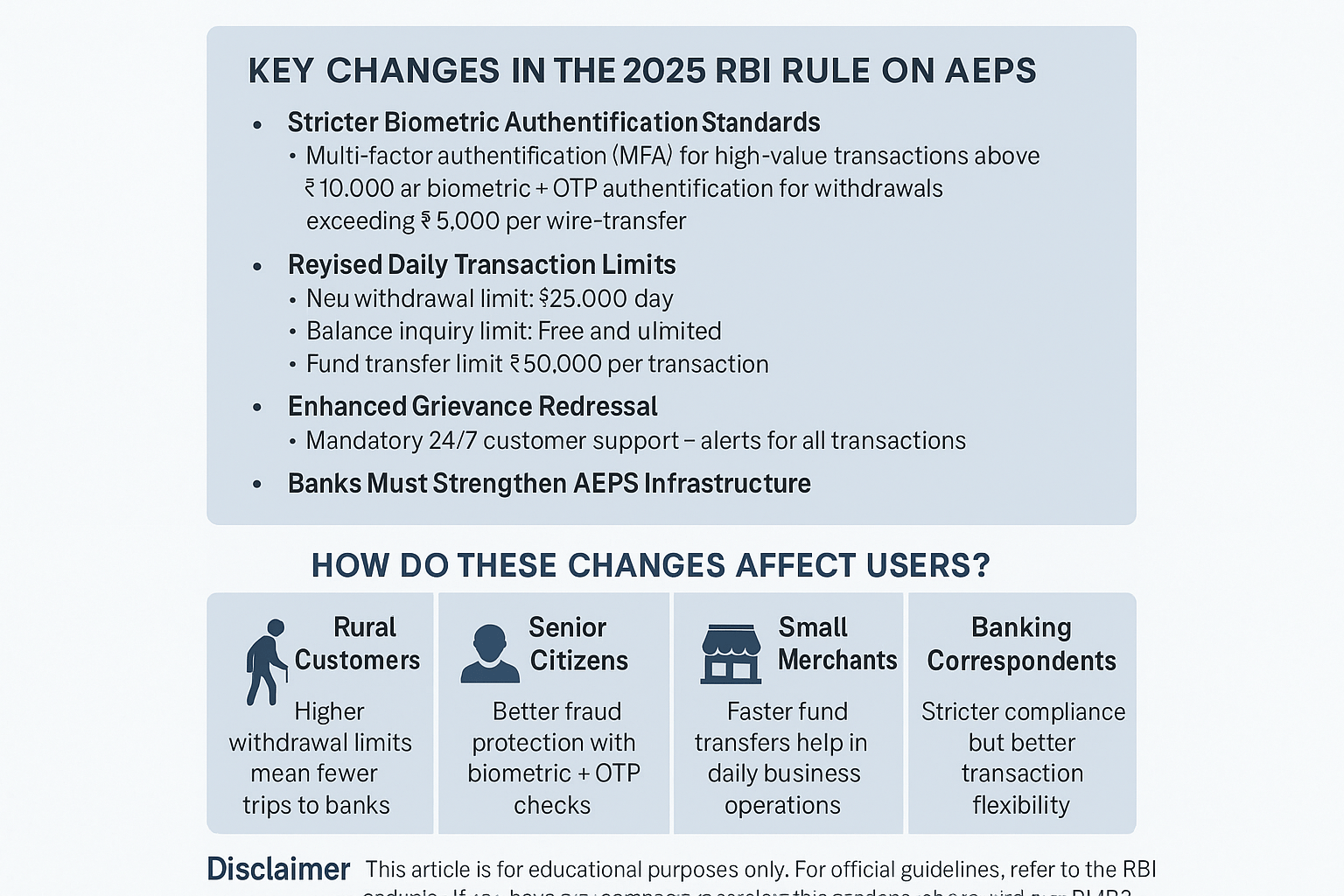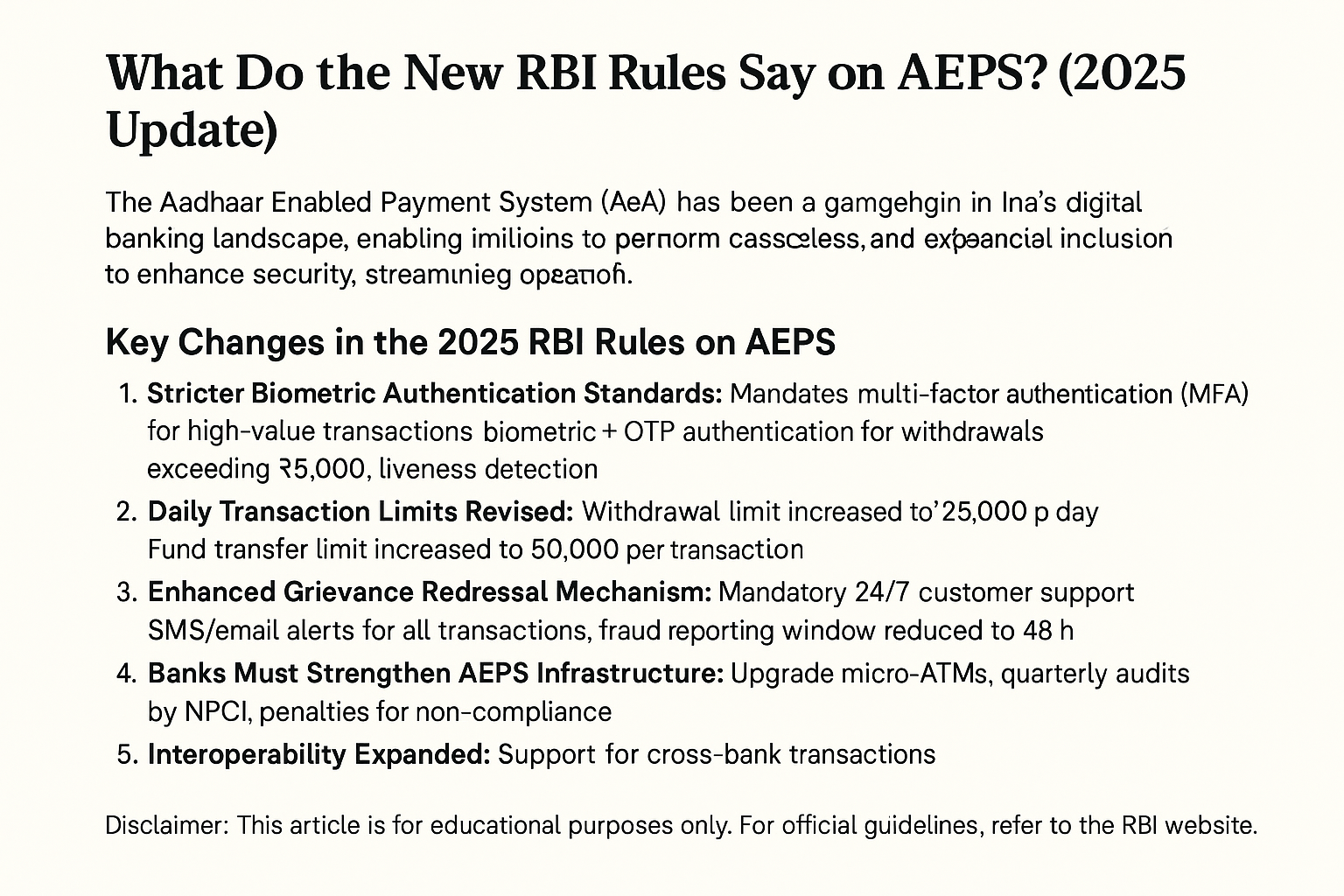The Aadhaar Enabled Payment System (AEPS) has been a game-changer in India’s digital banking landscape, enabling millions to perform cashless transactions using just their Aadhaar number and biometric authentication. In 2025, the Reserve Bank of India (RBI) introduced updated AEPS rules to enhance security, streamline operations, and expand financial inclusion.
This article breaks down the new RBI rules on AEPS, explaining key changes, their implications for users and banks, and what it means for India’s digital payment ecosystem.
Understanding AEPS: A Quick Recap
Before diving into the 2025 RBI updates, let’s quickly recap what AEPS is:
-
AEPS (Aadhaar Enabled Payment System) allows users to make banking transactions (like deposits, withdrawals, balance checks, and fund transfers) using their Aadhaar-linked bank account and biometric authentication (fingerprint/iris scan).
-
It was introduced by the National Payments Corporation of India (NPCI) to promote financial inclusion, especially in rural areas where smartphones and internet access are limited.
-
Transactions are processed through micro-ATMs or banking correspondents (BCs).
Now, let’s explore the latest RBI rules on AEPS and how they impact users and service providers.

Key Changes in the 2025 RBI Rules on AEPS
The RBI’s 2025 update on AEPS focuses on security enhancements, fraud prevention, and operational efficiency. Here are the major changes:
1. Stricter Biometric Authentication Standards
-
The RBI has mandated multi-factor authentication (MFA) for high-value AEPS transactions (above ₹10,000).
-
Biometric + OTP authentication will now be required for withdrawals exceeding ₹5,000 to curb fraud.
-
Banks must implement liveness detection to prevent spoofing attacks (where fraudsters use fake fingerprints).
Why this matters:
“With rising cases of Aadhaar-linked fraud, RBI’s move to enforce stricter biometric checks ensures that only genuine users can access their funds.” – Banking Industry Expert
2. Daily Transaction Limits Revised
-
New withdrawal limit: ₹25,000 per day (previously ₹10,000).
-
Balance inquiry limit: No change (remains free and unlimited).
-
Fund transfer limit: Increased to ₹50,000 per transaction (from ₹25,000).
Example:
A farmer in a remote village can now withdraw up to ₹25,000 in a single day without visiting a bank branch.
3. Enhanced Grievance Redressal Mechanism
-
Mandatory 24/7 customer support for AEPS-related complaints.
-
SMS/email alerts for every transaction, even for small amounts.
-
Fraud reporting window reduced from 7 days to 48 hours for faster resolution.
4. Banks Must Strengthen AEPS Infrastructure
-
Banks and BCs (Banking Correspondents) must upgrade micro-ATMs to support new security protocols.
-
NPCI will conduct quarterly audits to ensure compliance.
-
Penalties for non-compliance increased to ₹5 lakh per violation.
5. Interoperability Expanded
-
AEPS now supports cross-bank transactions seamlessly.
-
Users can withdraw money from any bank’s micro-ATM, not just their own bank’s.
How Do These Changes Affect Users?
| User Group | Impact of New RBI AEPS Rules |
|---|---|
| Rural Customers | Higher withdrawal limits mean fewer trips to banks. |
| Senior Citizens | Better fraud protection with biometric + OTP checks. |
| Small Merchants | Faster fund transfers help in daily business operations. |
| Banking Correspondents | Stricter compliance but better transaction flexibility. |
Challenges & Concerns
While the new RBI rules on AEPS bring improvements, some challenges remain:
-
Biometric Failures: Rural users with worn-out fingerprints may face authentication issues.
-
Infrastructure Costs: Banks and BCs must invest in upgraded devices, which could slow adoption.
-
Fraud Risks: Despite new measures, phishing scams and fake micro-ATMs are still a threat.
The Future of AEPS in India
The RBI’s 2025 AEPS updates indicate a strong push toward secure, accessible digital banking for all. With UPI and AePS integration in the works, India’s payment ecosystem is set to become even more robust.
“AEPS is no longer just for rural India—it’s evolving into a mainstream payment solution.” – NPCI Spokesperson

Frequently Asked Questions (FAQs)
1. What is the new daily withdrawal limit under AEPS?
The RBI has increased the limit to ₹25,000 per day (up from ₹10,000).
2. Do I need an OTP for AEPS transactions now?
Only for high-value transactions (above ₹5,000)—biometric + OTP will be required.
3. Can I use any bank’s micro-ATM for AEPS transactions?
Yes! The new rules enforce full interoperability, so any micro-ATM will work.
4. What if my fingerprint fails during authentication?
Banks must provide alternate authentication methods, such as iris scan or OTP.
5. How can I report an AEPS fraud?
You must report within 48 hours via your bank’s helpline or the RBI’s Sachet portal.
Final Thoughts
The new RBI rules on AEPS (2025) strike a balance between security and convenience, ensuring that India’s most vulnerable populations can access banking services safely. While challenges like biometric failures persist, the upgrades signal a stronger, fraud-resistant AEPS framework for the future.
As digital payments grow, staying informed about these changes will help users maximize benefits while minimizing risks.
Disclaimer
This article is for educational purposes only. For official guidelines, refer to the RBI website. If you have any concerns regarding this content, please visit our DMCA page for removal requests. Always verify updates with authorized financial institutions.
